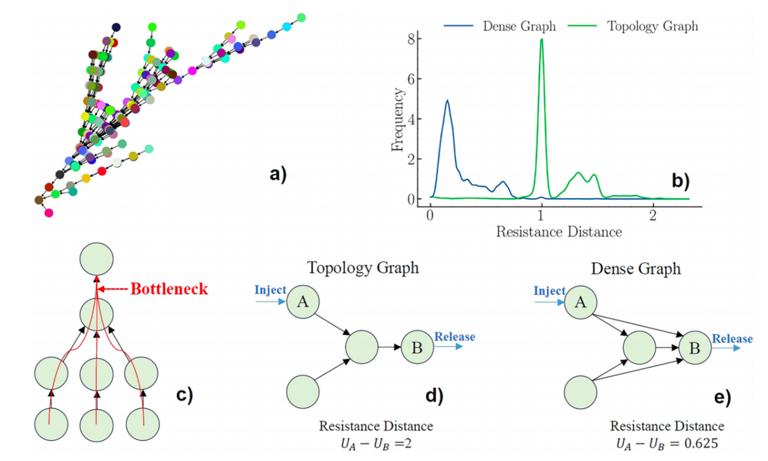The increasing frequency and intensity of floods, exacerbated by climate change, necessitates the development of accurate and timely flood forecasting models. Although AI-based approaches have demonstrated promise, the effectiveness of graph neural networks (GNNs) in modeling the intricate dynamics of river networks remains contested. Despite the natural alignment between river topology and graph-based structures, recent studies reveal that GNNs often underperform in fully utilizing this structural information.
This research aims to identify the underlying factors contributing to this limitation. Our analysis reveals that the tree-like configuration of river networks leads to oversquashing in GNNs, a problem caused by high resistance distances between nodes. To address this, we propose a novel method that transforms the topological graph into a dense, reachability-based graph, which reduces resistance distances. Empirical results demonstrate that GNNs applied to the transformed graph outperform EA-LSTM, particularly in predicting rare and extreme flood events. Furthermore, the incorporation of graph information significantly enhances long-term forecasting capabilities, as evidenced by the fact that, on average, GNN predictions of water levels at 24 h after using the dense graph match the accuracy of EA-LSTM’s 14-h forecasts. These findings highlight the potential of graph-based methodologies to improve flood prediction systems and contribute to more effective early warning mechanisms.

The global hydrological cycle is undergoing significant anthropogenic alterations, with far-reaching implications for flood risk and water resource management highlighted the increasing risk of extreme precipitation events due to climate change, while refs. projected a substantial increase in global flood risk under future climate scenarios. The increasing frequency and complexity of flood events have spurblack significant developments in flood forecasting methodologies.
Traditional approaches integrate meteorological inputs with hydrological processes to simulate rainfall-runoff dynamics and channel flows. However, uncertainties in precipitation forecasts often limit the accuracy of these models. Recent advances in machine learning have introduced new possibilities, with LSTM networks demonstrating particular promise in capturing both linear and non-linear memory effects in hydrological time series modeling. Convolutional Neural Networks (CNNs), though originally developed for image processing, have also proven effective inpblackicting hydrological time series.
This study challenges prior assumptions about river network topology's role in flood forecasting by revealing that tree-like structures induce over-squashing in Graph Neural Networks (GNNs), limiting predictive accuracy. By implementing dense graph structures instead, the study unlocks critical topological information, substantially improving long-term and extreme flood event predictions. Dense configurations consistently outperformed across GNN architectures, with attention mechanisms excelling in extreme scenarios—suggesting potential for hybrid models.
While constrained by the LamaH-CE dataset’s regional focus, the approach bridges graph theory and hydrology, demonstrating that robust topological representation enhances flood resilience amid climate-induced risks. This foundation advances AI-driven forecasting, enabling more effective disaster management and mitigation strategies.
Sources:
natural hazards
https://www.nature.com/articles/s44304-025-00083-6 .
Provided by the IKCEST Disaster Risk Reduction Knowledge Service System
Comment list ( 0 )
